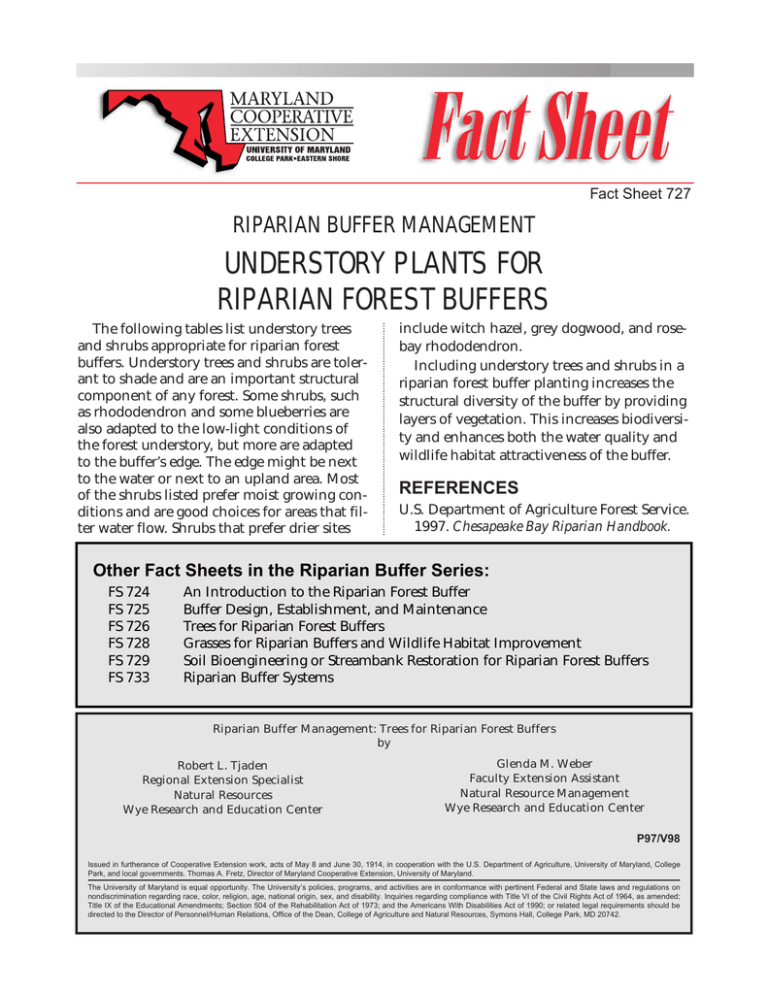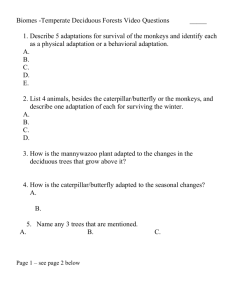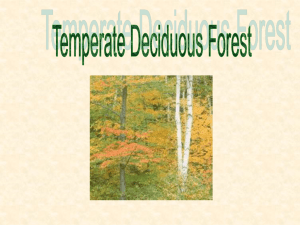UNDERSTORY PLANTS FOR RIPARIAN FOREST BUFFERS RIPARIAN BUFFER MANAGEMENT Fact Sheet 727
advertisement

Fact Sheet 727 RIPARIAN BUFFER MANAGEMENT UNDERSTORY PLANTS FOR RIPARIAN FOREST BUFFERS The following tables list understory trees and shrubs appropriate for riparian forest buffers. Understory trees and shrubs are tolerant to shade and are an important structural component of any forest. Some shrubs, such as rhododendron and some blueberries are also adapted to the low-light conditions of the forest understory, but more are adapted to the buffer’s edge. The edge might be next to the water or next to an upland area. Most of the shrubs listed prefer moist growing conditions and are good choices for areas that filter water flow. Shrubs that prefer drier sites include witch hazel, grey dogwood, and rosebay rhododendron. Including understory trees and shrubs in a riparian forest buffer planting increases the structural diversity of the buffer by providing layers of vegetation. This increases biodiversity and enhances both the water quality and wildlife habitat attractiveness of the buffer. REFERENCES U.S. Department of Agriculture Forest Service. 1997. Chesapeake Bay Riparian Handbook. Other Fact Sheets in the Riparian Buffer Series: FS 724 FS 725 FS 726 FS 728 FS 729 FS 733 An Introduction to the Riparian Forest Buffer Buffer Design, Establishment, and Maintenance Trees for Riparian Forest Buffers Grasses for Riparian Buffers and Wildlife Habitat Improvement Soil Bioengineering or Streambank Restoration for Riparian Forest Buffers Riparian Buffer Systems Riparian Buffer Management: Trees for Riparian Forest Buffers by Robert L. Tjaden Regional Extension Specialist Natural Resources Wye Research and Education Center Glenda M. Weber Faculty Extension Assistant Natural Resource Management Wye Research and Education Center P97/V98 Issued in furtherance of Cooperative Extension work, acts of May 8 and June 30, 1914, in cooperation with the U.S. Department of Agriculture, University of Maryland, College Park, and local governments. Thomas A. Fretz, Director of Maryland Cooperative Extension, University of Maryland. The University of Maryland is equal opportunity. The University’s policies, programs, and activities are in conformance with pertinent Federal and State laws and regulations on nondiscrimination regarding race, color, religion, age, national origin, sex, and disability. Inquiries regarding compliance with Title VI of the Civil Rights Act of 1964, as amended; Title IX of the Educational Amendments; Section 504 of the Rehabilitation Act of 1973; and the Americans With Disabilities Act of 1990; or related legal requirements should be directed to the Director of Personnel/Human Relations, Office of the Dean, College of Agriculture and Natural Resources, Symons Hall, College Park, MD 20742. 2 Low High Medium High Low High CP, P CP, P, M P, M CP, P CP P, M CP, P P, M P, M CP CP, P, M CP, P, M P, M Common ninebark Elderberry Grey dogwood Highbush blueberry Inkberry Maple-leaf viburnum Pinxterbloom azalea Possumhaw Pussy willow Red chokeberry Red osier dogwood Rosebay rhododendron Silky dogwood Wildlife Value = food source for wildlife Light Preference: ❍ = full sunlight ◗ = partial shade ●= shade Medium V. high V. high V. high High High P, M CP, P, M Blackhaw Buttonbush Medium High MediumHigh High CP Bayberry Medium CP, P, M Wildlife Value V. high High Medium Low Arrowwood viburnum Coastal plain (CP) Piedmont (P) Mountains (M) Region Riparian Understory Shrubs High High High High Low High High Low High High Medium High High Low Medium ❍/◗ ❍/◗ ❍ ❍/◗ ❍/◗ ❍/◗ ❍/◗ ◗/● ◗/● ❍/◗ ❍ ❍/◗ ❍/◗ ◗/● ❍/◗ Slow Fast Slow Fast Fast Slow Medium Fast Fast Medium Slow Slow MediumSlow Medium Medium Medium Medium Growth Rate V. fast Fast Medium Slow Evergreen Deciduous Deciduous Deciduous Deciduous Low = does not tolerate flooding/high water Shallow Shallow (good bank stabilizer) Shallow Shallow Shallow Shallow Shallow Shallow Deciduous Deciduous Deciduous Shallow Shallow Shallow Shallow Shallow Shallow Shallow Shallow Shallow Rooting Deciduous Deciduous Deciduous Deciduous Evergreen Deciduous Deciduous Deciduous/ Evergreen Deciduous Deciduous/ Evergreen High = tolerates flooding/high water High ❍ Flood Tolerance: Medium Flood Tolerance High Medium Low ❍/◗ Light Preference ❍◗● 3 M CP, P, M CP, P CP, P CP, P, M P, M CP, P P, M Speckled alder Spicebush Swamp azalea Swamp leucothoe Sweet pepperbush Virginia sweetspire Winterberry Witch-hazel Wildlife Value = food source for wildlife Light Preference: ❍ = full sunlight ◗ = partial shade ●= shade P, M Smooth alder Coastal plain (CP) Piedmont (P) Mountains (M) Region Riparian Understory Shrubs (continued) Low High Medium V. high Low Low High Low Medium Wildlife Value V. high High Medium Low High Medium High Medium High High High Low ❍ ●/◗ ❍/◗ ◗/● ❍/◗ ❍/◗ ❍/◗ ❍/◗ Medium MediumFast Fast Fast Medium Slow Medium MediumSlow Slow Growth Rate V. fast Fast Medium Slow Shallow Shallow (seasonally flooded areas) Deep lateral Deciduous Deciduous Deciduous Shallow Shallow Deep lateral Shallow Shallow Shallow Rooting Deciduous Deciduous Deciduous Deciduous Evergreen Deciduous Deciduous/ Evergreen Low = does not tolerate flooding/high water High = tolerates flooding/high water High ❍/◗ Flood Tolerance: Flood Tolerance High Medium Low Light Preference ❍◗● 4 CP, P, M CP, P, M CP, P, M P CP, P P, M CP, P, M P, M CP, P Hophornbeam Pawpaw Persimmon Redbud Sassafras Shad-bush Sweet bay magnolia Wildlife Value = food source for wildlife Light Preference: ❍ = full sunlight ◗ = partial shade ●= shade V. highHigh Medium High High V. lowLow Medium V. high Medium High P, M American hornbeam Boxelder Flowering Dogwood Hawthorn P, M MediumHigh Medium CP, P Wildlife Value V. high High Medium Low High American holly Coastal plain (CP) Piedmont (P) Mountains (M) Region Riparian Understory Trees Medium Slow Slow Fast Slow <30’ <50’ <50’ <50’ 30-40’ 30-40’ <30’ <30’ Medium Slow Slow 30-40’ 30-40’ >50’ 30-40’ Height (feet) >75’ 50-75’ <50’ Slow Slow V. fast Slow Growth Rate V. fast Fast Medium Slow Deep lateral Deep taproot Shallow Shallow Shallow Deep lateral Shallow Shallow Shallow Deep lateral Deep lateral Taproot Rooting Low = does not tolerate flooding/high water High = tolerates flooding/high water Medium ◗ Flood Tolerance: Medium High Low High ❍ ◗ ❍ ◗/● ❍/◗/● ◗/● ❍/◗/● ❍ Low LowMedium Low LowMedium MediumLow MediumLow High ◗ ◗/● ❍ Flood Tolerance High Medium Low Light Preference ❍◗●




